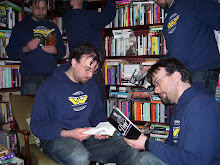In any respectable apocalypse connoisseur's list of the great books, John Christopher (born 1922) will be found, alongside John Wyndham, with whom he has often and reasonable been compared. Unlike Wyndham, Christopher (real name Sam Youd) is still alive and writing, though very little of his output oiver the last couple of decades has been science-fiction. Nor is it under the name of John Christopher, who is still perhaps best known for his children's Tripods trilogy.
Christopher has published widely under nine different names: Anthony Rye, Christopher Youd, John Christopher, Hilary Ford, Peter Graaf, Stanley Winchester, Samuel Youd, William Godfrey and, most recently, Peter Nichols. Usually the different names go with different writing genres, John Christopher being his SF name.
His four end-of-the-world novels (three of them masterpieces) were first published in the 1950s and 1960s. As far as I can tell, they're all now out of print. Here are the covers of the editions I own.
The Death of Grass (1956): This edition is the Penguin film tie-in from 1970, with a cover photo by Dan Budnik. The so-so film used the US title, No Blade of Grass. A grass-killing virus destroys the world's crops, leading to riots, starvation and the collapse of civilisation. Youd's 9th book.

The World in Winter (1962): This is the 1964 penguin paperback, with a lovely silkscreen-style image (by Bruce Robertson) of a lone car struggling through a snow-paralysed London. A sudden new ice age hits the world, with dire consequences. Interestingly enough, the European winter after this was first published was especially severe, a fact alluded to on the back cover. Youd's 21st book.

A Wrinkle in the Skin (1965): This edition is the 1978 Sphere edition; the US title was The Ragged Edge. This time it's massive tectonic activity which destroys civilisation: the surface of the globe is rearranged overnight, killing almost everybody, reshaping continents and oceans, wiping out cities. Great stuff. The cover painting of the remnants of Heathrow is by an uncredited artist. Youd's 28th book.

Pendulum (1968): This is the hardcover Michael Joseph reprint from 1974, also with an uncredited cover artist. Perhaps ending the world thrice in a decade was wearing a bit thin by this point, as this is the only one of these novels which doesn't completely convince and enthral the reader. Economic stagnation and collapsing social conventions are at fault for ending civilisation in this novel, and it gives the book a disgruntled-old-man vibe. It's still good, but disappointing compared to the others. Youd's 35th book (bloody hell!).

 So, you have your instructions: seek these books out. If you're a publisher, reptint them. And if you have children you'd like to inspire with an introduction to world-ending literature, try the The Tripods, or Empty World, or The Prince in Waiting (civilisation ended by aliens, plague and tectonics (again) respectively). They'll thank you, or else spend the rest of their lives plagued by apocalyptic nightmares. It's all part of life's rich tapestry.
So, you have your instructions: seek these books out. If you're a publisher, reptint them. And if you have children you'd like to inspire with an introduction to world-ending literature, try the The Tripods, or Empty World, or The Prince in Waiting (civilisation ended by aliens, plague and tectonics (again) respectively). They'll thank you, or else spend the rest of their lives plagued by apocalyptic nightmares. It's all part of life's rich tapestry.




2 comments:
'Bad Dream' (published 2003) is also a Christopher cracker! See http://www.amazon.co.uk/Bad-Dream-John-Christopher/dp/0727859609/ref=sr_1_5?ie=UTF8&s=books&qid=1203971559&sr=1-5 ...
I haven't read that one yet, though I do have it somewhere in the teetering piles. Must hunt it out.
Post a Comment